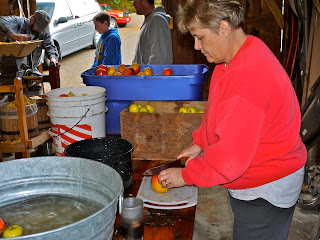Hank’s Grandpa Huckins’s cider press received its patent in 1872. It was well-used for generations. Finally the wooden parts rotted away. When Don Frick found it a few years ago, it was just a pile of cast-iron pieces. This gifted jack-of-all-trades saw possibilities in the fragments, so he saved them.
Then, while visiting the museum in the northwest Washington community of Lyndon, he saw the same type of press on display, all the pieces in place and the wooden sections in good condition. He asked permission to take photographs and measurements, then went home and replicated the missing parts. A few cast iron fittings were also missing, so he had them reproduced in brass. He cleaned and reassembled the cider press. It worked!
Here’s how to make cider the old fashioned way:
First, pick your apples. They don't have to be perfect.
Next, wash the apples and chop into quarters.
 |
| Pour the apple pieces into the hopper. |
 |
| Turn the crank to grind the apples. Repeat until the wooden barrel is full. |
|
 |
| Center the full bucket under the press, put the template over the apples, and turn the handle to squeeze the juice from the ground fruit. (The barrel has a removable bottom. A net is place inside before the apples go in.) | | |
 |
| Don uses a straight-grained three x four for added leverage. The cider runs between the wooden slats of the container and through a cheese-cloth filter into the metal bucket. A second container of apple waits to become cider. The leftover pulp makes a treat for visiting deer. | |
Almost done. Now the cider goes into a stainless steel vat to be heated over a gas burner to a temperature of 172 degrees. If allowed to get too hot, the pectin in the juice will separate out, ruining the cider.
The pasturized cider goes into jugs. It will keep unfrozen for a couple of weeks, or can be frozen indefinitely.
A tall glass of chilled cider. Delicious!










I rinse my apples and then soak them in a sanitizing solution of 1 T bleach to 1 gallon of water for five minutes. I rinse them again and sanitize the apple press by spraying with the same solution contained in a sprayer. If you do not sanitize the apples, do not taste the apple juice until your pasteurize.
ReplyDeleteWith my sanitizing methods, I can taste the juice immediately, while cold and fresh from the press!